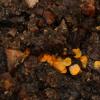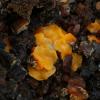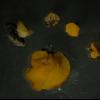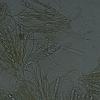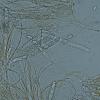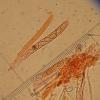
24-12-2025 17:08
Hulda Caroline HolteHello, I have found this propoloid ascomycete on

21-12-2025 09:32
Hello.A tiny ascomycete found embedded in wood in

21-12-2025 21:32
Pol DebaenstHello, Garden, Burgweg 19, Veurne, BelgiumOn 10/1

22-12-2025 23:38
Patrice TANCHAUDBonsoir, récolte sur un mur en pierre, apothéci

22-12-2025 00:47
Patrice TANCHAUDBonsoir, récolte à proximité du milieu dunaire
ID for this orange-amber cupulate Asco.
Stephen Martin Mifsud,
17-12-2016 21:59
 I've just collected the data and micrographs of another small, orange-yellow (quite dull) sessile (or very shortly stipitate) discoid ascomycete (Pezizales) which I would like to share in this forum for help.
I've just collected the data and micrographs of another small, orange-yellow (quite dull) sessile (or very shortly stipitate) discoid ascomycete (Pezizales) which I would like to share in this forum for help. Spores without distinct oil bodies, ellipsoid, (9.1-)10.8 (-12.0) x (5.5-)6.5 (-7.1) um (Qe = 1.67x). Paraphyses threadlike 1-2um wide, sometime branching once into two branches, tips often curled not more than 3/4 of a loop. Asci J-ve.
Uwe Lindemann,
17-12-2016 22:37
Re : Trying to ID this orange-amber cupulate Asco.
Hi Stephen,
it looks like a member of the Boubovia-Pulvinula group. Possibly Boubovia nicholsonii (Massee) Spooner & Y.J. Yao, see here http://www.asturnatura.com/fotografia/setas-hongos/boubovia-nicholsonii-massee-crossl-spooner-y-j-yao-1/17688.html
If you could send me a part of your collection I would be glad to study it.
Best, Uwe
it looks like a member of the Boubovia-Pulvinula group. Possibly Boubovia nicholsonii (Massee) Spooner & Y.J. Yao, see here http://www.asturnatura.com/fotografia/setas-hongos/boubovia-nicholsonii-massee-crossl-spooner-y-j-yao-1/17688.html
If you could send me a part of your collection I would be glad to study it.
Best, Uwe
Stephen Martin Mifsud,
17-12-2016 23:14

Re : Trying to ID this orange-amber cupulate Asco.
Dear Uwe,
I would be more than happy to submit a sample. I guess you need a fresh sample on some substrate in a closed container. Hope there's more left, but the current cold and rainy weather might repopulate more individuals. The habitata was quite artificial. It was some kind of animal bedding dumped on soil. The bedding consisted of wooden chips, gravel and possibly old excreta but not dung. It was lying on clayey calcareous soil.
I followed a key (American) and led me to the genus Byssonectria, which had Paraphyses also with curled tips, but the spores were too much fusifoem. Well, I will check in depth tomorrow morning Zzz....
http://www.discoverlife.org/mp/20q?search=Byssonectria
Send me your postal address through my email (check my profile!)
Interesting!
I would be more than happy to submit a sample. I guess you need a fresh sample on some substrate in a closed container. Hope there's more left, but the current cold and rainy weather might repopulate more individuals. The habitata was quite artificial. It was some kind of animal bedding dumped on soil. The bedding consisted of wooden chips, gravel and possibly old excreta but not dung. It was lying on clayey calcareous soil.
I followed a key (American) and led me to the genus Byssonectria, which had Paraphyses also with curled tips, but the spores were too much fusifoem. Well, I will check in depth tomorrow morning Zzz....
http://www.discoverlife.org/mp/20q?search=Byssonectria
Send me your postal address through my email (check my profile!)
Interesting!
Uwe Lindemann,
17-12-2016 23:24
Re : Trying to ID this orange-amber cupulate Asco.
I have already sent you an email with my address :-)
Best, Uwe
Best, Uwe
Stephen Martin Mifsud,
18-12-2016 08:55

Re : Trying to ID this orange-amber cupulate Asco.
I agree, it's more than likely Boubovia sp. (this genus not in the keys I used); not Byssonectria. It is a relatively new genus and from what I gather the paraphyses with blobby pigments and curled apices are imp. characters.
Hope to send you a sample soon
Hope to send you a sample soon

